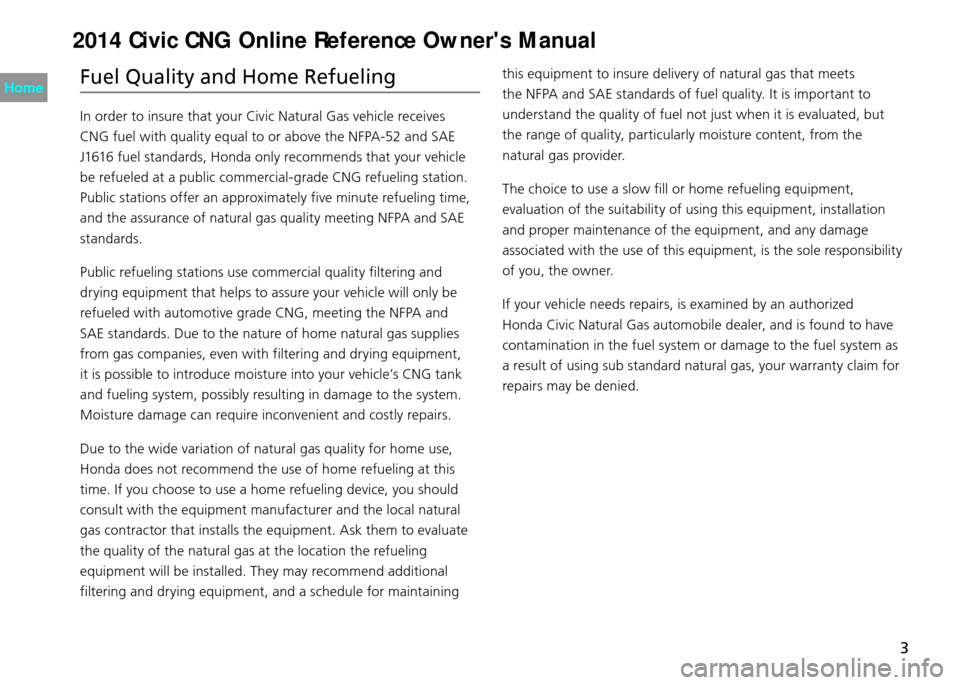Page 4 of 46

Fuel Quality and Home Refueling
In order to insure that your Civic Natural Gas vehicle receives
CNG fuel with quality equal to or above the NFPA-52 and SAE
J1616 fuel standards, Honda only recommends that your vehicle
be refueled at a public commercial-grade CNG refueling station.
Public stations offer an approximately five minute refueling time,
and the assurance of natural gas quality meeting NFPA and SAE
standards.
Public refueling stations use commercial quality filtering and
drying equipment that helps to assure your vehicle will only be
refueled with automotive grade CNG, meeting the NFPA and
SAE standards. Due to the nature of home natural gas supplies
from gas companies, even with filtering and drying equipment,
it is possible to introduce moisture into your vehicle’s CNG tank
and fueling system, possibly resulting in damage to the system.
Moisture damage can require inconvenient and costly repairs.
Due to the wide variation of natural gas quality for home use,
Honda does not recommend the use of home refueling at this
time. If you choose to use a home refueling device, you should
consult with the equipment manufacturer and the local natural
gas contractor that installs the equipment. Ask them to evaluate
the quality of the natural gas at the location the refueling
equipment will be installed. They may recommend additional
filtering and drying equipment, and a schedule for maintaining this equipment to insure delivery of natural gas that meets
the NFPA and SAE standards of fuel quality. It is important to
understand the quality of fuel not just when it is evaluated, but
the range of quality, particularly moisture content, from the
natural gas provider.
The choice to use a slow fill or home refueling equipment,
evaluation of the suitability of using this equipment, installation
and proper maintenance of the equipment, and any damage
associated with the use of this equipment, is the sole responsibility
of you, the owner.
If your vehicle needs repairs, is examined by an authorized
Honda Civic Natural Gas automobile dealer, and is found to have
contamination in the fuel system or damage to the fuel system as
a result of using sub standard natural gas, your warranty claim for
repairs may be denied.
32014 Civic CNG Online Reference Owner's Manual
Page 22 of 46

21
Maintenance
Maintenance MinderTM To Use Maintenace MinderTM
Maintenance Service Items
2345
Maintenance Service ItemsIndependent of the Maintenance Minder
•information, replace the brake fluid every 3 years.
Inspect idle speed every 160,000 miles (256,000
•km).
Adjust the valves during services A, B, 1, 2, or 3 if
•they are noisy.
CODE Maintenance Main Items
A Replace engine oil •
*1
B Replace engine oil• *1 and oil filter
Replace fuel filter element (low pressure)
•
Drain fuel filter (high pressure)
•
Inspect front and rear brakes/service as necessary
•
Check parking brake adjustment
•
Inspect tie rod ends, steering gearbox, and boots
•
Inspect suspension components
•
Inspect driveshaft boots
•
Inspect brake hoses and lines (Including ABS/ VSA)
•
Inspect all fluid levels and condition of fluids
•
Inspect exhaust system
• #
Inspect fuel lines and connections
• #
Check the expiration date for TRK bottle
• *2
CODE Maintenance Sub Items
1 Rotate tires •
2 Replace air cleaner element• *3
Replace dust and pollen filter
• *4
Replace fuel filter element (high pressure)
•
Inspect drive belt
•
Inspect valve clearance
•
Inspect fuel tank
• *5
3 Replace transmission fluid •
4 Replace spark plugs•
5 Replace engine coolant•
*1: If a message SERVICE does not appear more than 12 months after the display is reset, change the
engine oil every year.
*2: Models with tire repair kit
# : See information on maintenance and emissions warranty. *3: If you drive in dusty conditions, replace the air cleaner element every 15,000 miles (24,000 km).
*4: If you drive primarily in urban areas that have high concentrations of soot in the air from industry and
from diesel-powered vehicles, replace the dust and pollen filter every 15,000 miles (24,000 km).
*5: If sub item 2 does not appear more than 36 months after the display is reset, inspect the fuel tank
every three years.
See CNG tank expiration and production dates on page 5 for inspection and replacement
information. Fuel tank should be replaced 15 years after it was manufactured.
System Message
Indicator
Maintenance Minder
Message
Main
Item Sub Items
2014 Civic CNG
Page 45 of 46
Fuel System
44
Information
System Components
Fuel Feed Line
Fuel Pressure
Regulator Fuel Tank
Fuel Receptacle
Fuel Filter
(Low Pressure) Fuel Injector
Fuel Filter
(High Pressure) Manual Shut-Off
Valve System Components
Your vehicle’s fuel system includes a fuel tank, a
fuel pressure regulator, a manual shut-off valve,
high pressure fuel lines, and other components that
comply with NFPA-52 standards.
The system in your vehicle, including the tank
and hoses, has been designed to hold gas at this
pressure. It has also been tested for safety. You
should never smell gas or hear a hissing sound
unless you are refueling.
Never modify or replace any original components or
parts with those specified for a gasoline vehicle.
Improper parts or components can damage your
vehicle’s fuel system and affect your vehicle’s safety
performance.
Unlike some gasoline models, your vehicle’s rear
seat-back cannot be folded down.
2014 Civic CNG